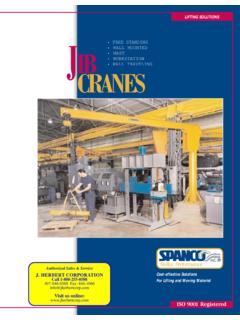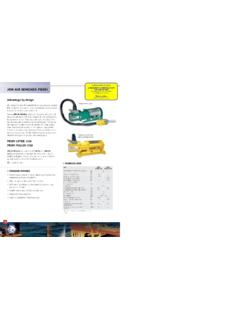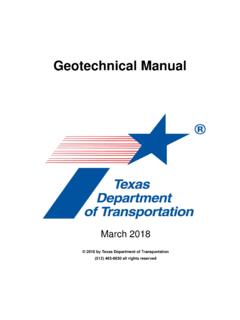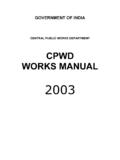Transcription of Form MHD56043 PARTS, OPERATION AND …
1 Form MHD56043 PARTS, OPERATION AND maintenance MANUALforPALAIR PLUSAIR CHAIN HOIST MODELSZinc Plated Load ChainPAL250 KPAL500 KPAL1000 KPAL1001 KPAL2000K( )( )(1metricton)(1metricton)(2metricton)(Dw g. MHP2227)(1 metric ton = 2200 lbs)Form MHD56043 Edition 3 December 200271073548 2002 Ingersoll-Rand CompanyREAD THIS manual BEFORE USING THESE PRODUCTS. This manualcontains important safety, installation, OPERATION and maintenanceinformation. Make this manual available to all persons responsible for theinstallation, OPERATION and maintenance of these not use this hoist for lifting, supporting, or transporting people or lifting orsupporting loads over operate, inspect and maintain this hoist in accordance with American NationalStandards Institute Safety Code (ASME ), European Security Rules and any otherapplicable safety codes and - Edition 3 TABLE OF CONTENTSD escriptionPage InformationDanger,Caution,WarningandNoti ce.
2 3 SafeOperatingInstructions .. 4 WarningTag .. 4 SpecificationsGeneralDescription .. 5 ModelCode-NorthAmericanHoistModels .. 6 ModelCode-European(CE)HoistModels ..7 Specifications .. 10 Motor .. 12 OperationInitial Operating Checks .. 15 PeriodicInspection .. 18 LubricationLubricationSchedule .. 19 GearCase .. 19 TroubleshootingTroubleshootingChart .. 22 GeneralDisassembly .. 24 Disassembly .. 24 Cleaning, 26 Assembly .. 29 Hoist 54 DesignUpdateSummary .. 56 MHD56043 - Edition 33 SAFETY INFORMATIONThis manual provides important information for all personnelinvolved with the safe installation, OPERATION and propermaintenance of this product. Even if you feel you are familiarwith this or similar equipment, you should read this manualbefore operating the , Warning, Caution and NoticeThroughout this manual there are steps and procedures which, ifnot followed, may result in a hazard. The following signal wordsDanger is used to indicate the presence ofa hazard whichwillcausesevereinjury,death, or substantial property damage ifthe warning is is used to indicate the presenceof a hazard whichcancausesevereinjury,death, or substantial property damage ifthe warning is is used to indicate the presence ofa hazard whichwillorcancause injury orproperty damage if the warning is used to notify people ofinstallation, OPERATION , or maintenanceinformation which is important but used to identify the level of potential SummaryWARNING Do not use this hoist or attached equipment for lifting,supporting, or transporting people or lifting or supportingloads over people.
3 The supporting structures and load-attaching devices used inconjunction with this hoist must provide an adequate safetyfactor to handle the rated load, plus the weight of the hoist andattached equipment. This is the customer s responsibility. If indoubt, consult a registered structural Lifting and handling equipment is subject to differentregulations in each country. These regulations may not bespecified in this National Safety Council, Accident Prevention manual forIndustrial operations , Eighth Edition and other recognized safetysources make a common point: Employees who work nearsuspended loads or assist in hooking on or arranging a loadshould be instructed to keep out from under the load. From asafety standpoint, one factor is paramount: conduct all lifting orpulling operations in such a manner that if there were anequipment failure, no personnel would be injured. This meanskeep out from under a raised load and keep out of the line of forceof any are manufactured in accordance with thelatest ASME Occupational Safety and Health Act of 1970 generally placesthe burden of compliance with the owner/employer, not themanufacturer.
4 Many OSHA requirements are not concerned orconnected with the manufactured product but are, rather,associated with the final installation. It is the owner s and user sresponsibility to determine the suitability of a product for anyparticular use. It is recommended that all applicable industry,trade association, federal, state and local regulations be all operating instructions and warnings before :It is the responsibility of the operator to exercisecaution, use common sense and be familiar with proper riggingtechniques. Refer to ASME for rigging information,American National Standards Institute, 1430 Broadway, NewYork, NY manual has been produced byIngersoll-Randto providedealers, mechanics, operators and company personnel withinformation required to install, operate, maintain and repair theproducts described is extremely important that mechanics and operators be familiarwith servicing procedures of these products, or like or similarproducts, and are physically capable of conducting theprocedures.
5 These personnel shall have a general workingknowledge that and safe use and application of mechanics commonhandtoolsaswellasspecialIngersoll- Randorrecommended procedures, precautions and work habits establishedby accepted industry know of, or provide all the procedures bywhich product operations or repairs may be conducted and thehazards and/or results of each method. If OPERATION ormaintenance procedures not specifically recommended by themanufacturer are conducted, it must be ensured that productsafety is not endangered by the actions taken. If unsure of anoperation or maintenance procedure or step, personnel shouldplace the product in a safe condition and contact supervisors and/or the factory for technical - Edition 3 SAFE OPERATING INSTRUCTIONSThe following warnings and operating instructions have beenadapted in part from American National (Safety) Standard and are intended to avoid unsafe operating practiceswhich might lead to injury or property that most companies who use hoistshave a safety program in force in their plants.
6 In the event thatsome conflict exists between a rule set forth in this publicationand a similar rule already set by an individual company, the morestringent of the two should take Operating Instructions are provided to make an operatoraware of dangerous practices to avoid and are not necessarilylimited to the following list. Refer to specific sections in themanual for additional safety allow people trained in safety and OPERATION of thisproduct to operate operate a hoist if you are physically fit to do allow people trained in safety, maintenance andtroubleshooting to perform service on a DO NOT OPERATE sign is placed on the hoistcontrols, do not operate hoist until sign has been removed bydesignated use a hoist which inspection indicates is not use hoist if hook latch has been sprung or that hook latches are engaged before splice a hoist chain by inserting a bolt between lift loads less than or equal to the rated capacity of thehoist.
7 Refer to hoist serial number When using two hoists to suspend one load, select two hoistseach having a rated capacity equal to or more than the provides adequate safety in the event of a sudden loadshift or failure of one Never place your hand inside the throat area of a Never use hoist chain as a Only operate a hoist when load chain is centered over thehook. Do not side pull or yard .14. Never operate hoist with twisted, kinked, capsized ordamaged load Do not force a chain or hook into place by Never insert the point of the hook into a chain Be certain load is properly seated in saddle of Do not support load on tip of Never run load chain over a sharp edge. Use a Pay attention to load at all times when operating Make sure everyone is clear of load path and there are noobjects in the way of load. Do not lift a load over Never use hoist for lifting or lowering people, and neverallow anyone to stand on a suspended Ease slack out of chain and sling when starting a lift.
8 Do notjerk the Do not swing a suspended Never leave a load suspended when hoist is not in Never weld or flame cut a load suspended by the Never use the hoist chain as a welding Do not operate hoist if chain jumping, excessive noise,jamming, overloading, or binding Keep the load from hitting the load Do not use the up and down emergency stop limit protectionas a normal means of stopping the Avoid unnecessary jogging of hoist and/or trolley Always rig loads properly and Shut off air supply before performing any Avoid collision or bumping of After use, or when in a non-operational mode, the unitshould be secured against unauthorized and unwarranted TAGEach hoist is supplied from the factory with the warning tagshown. If tag is not attached to your hoist, order a new tag andinstall it. Refer to parts list for part number. Read and obey allwarnings and other safety information attached to this hoist.
9 Tagis shown smaller than actual - Edition 35 SPECIFICATIONSG eneral DescriptionThePalair Plushoist is a lube-free* air powered hoist designedto lift and lower loads. ThePalair Plushoist may be hookmounted to the suspension shaft of a trolley or a permanentmounting structure. Using a fixed lug, hoist may also be mounteddirectly to a trolley. The air supply line can be strung to the hoistusing either hose hangers or hose Plushoists are driven by a lube-free* gear motorconnected to a pinion shaft, and planetary reduction gear. Outputfrom the planetary reduction gear drives the load chain shaft is also coupled to the brake discs. The brake isengaged at all times, until the hoist is powered in either the raiseor lower direction. System pressure acts on brake piston to releasethe spring-applied brake during hoist top and bottom limit switches are integrated into the hoistbody and are activated by buffers attached to the load overload protection and emergency stop features aredesigned into the hoist motor assembly.
10 OPERATION of theemergency stop feature is integrated into the hoist pendant.* Lube-free means that no lubrication to the supply air is requiredfor these hoists, and therefore no oil mist is exhausted to This edition of the manual incorporates changes covered insupplement MHD56043 SUP. Hoists with serial numbersending in letter E or with serial number 940100 and higher DESIGNUPDATE SUMMARY on page 54 is included to allow olderhoist versions to be repaired and - Edition 3 Model Code Explanation - North American ModelsExample: PAL250K-3HD18-6 UPAL250K3HD186 USeries:PAL= Palair Chain HoistPALP=Palair Premium Chain HoistHoist Capacity:PAL Models (Zinc plated load chain)250= 250 kg (550 lbs)500= 500 kg (1100 lbs)1000= 1000 kg (2200 lbs)PALP Models (Nickel Diffused load chain)250=250kg(550lbs)500= 500 kg (1100 lbs)1000= 1000 kg (2200 lbs)Performance:K= StandardControl Pendant:0=No Controls1=Rope/Chain Control2=1 Motor (hoist only)3= 2 Motor (hoist and motorized trolley)4=3 MotorSuspension.











